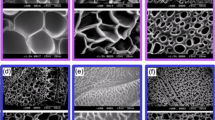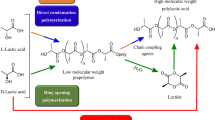Abstract
Hydroxypropyl methylcellulose (HPMC) is a hydrophilic retarding-release polymer with the limited application in hot melt extrusion (HME) due to its high glass transition temperature (Tg 181–191°C) and melt viscosity. The aim of this study is to develop hot melt extruded matrices using hydroxypropyl cellulose (HPC) and felodipine (FLDP) with HPMC for controlled release and explore the relations of their specialty, processability, and structure with the product properties. Results showed that FLDP/HPCEF/HPMC can be extruded at 160°C with torques not more than 0.5 N·m. The extruded matrices of FLDP/HPCEF/HPMCK15M (10:45:45 and 30:35:35) achieved the controlled release for 24 h. Rheological behaviors demonstrated that HPCEF and FLDP were miscible with HPMCK15M, attaining maximum 30% FLDP soluble in the molten mixtures. HPCEF and FLDP decreased the complex viscosity and plasticized HPMCK15M to improve the extrusion processing. DSC and FT-IR indicated that the molten soluble FLDP was amorphous in the extruded matrices by hydrogen bonding with HPCEF/HPMCK15M. SEM/energy-dispersive X-ray microanalysis illustrated that the microstructure of extrudates was surface dense and interior loose, and FLDP was homogenously dispersed. Three-point bending test revealed that the plasticizers of HPCEF and FLDP contributed differently to the mechanical properties. HPCEF decreased the flexural modulus of HPMCK15M while that of HPCEF/HPMCK15M was increased by FLDP. Besides controlled release, low moisture absorption and enhanced stability were also the correlated achievements. Therefore, HPCEF-combined poorly water-soluble drugs to plasticize HPMCK15M provide an alternative novel potential approach to realize the controlled-release delivery via HME.










Similar content being viewed by others
Abbreviations
- APIs:
-
Active pharmaceutical ingredients
- ASDs:
-
Amorphous solid dispersions
- ChP:
-
Chinese Pharmacopoeia
- DSC:
-
Differential scanning calorimetry
- EDX:
-
Energy-dispersive X-ray microanalysis
- FLDP:
-
Felodipine
- FT-IR:
-
Fourier transform infrared spectroscopy
- HME:
-
Hot melt extrusion
- HPC:
-
Hydroxypropyl cellulose
- HPMC:
-
Hydroxypropyl methylcellulose
- PBS:
-
Phosphate-buffered solution
- PEG:
-
Polyethylene glycol
- PG:
-
Propylene glycol
- PMs:
-
Physical mixtures
- RH:
-
Relative humidity
- SDS:
-
Sodium dodecyl sulfate
- SEM:
-
Scanning electron microscopy
- T g :
-
Glass transition temperature
- T m :
-
Melting temperature
- USP:
-
United States Pharmacopoeia
- UV:
-
Ultraviolet
References
Van Renterghem J, Kumar A, Vervaet C, Remon JP, Nopens I, Vander Heyden Y, et al. Elucidation and visualization of solid-state transformation and mixing in a pharmaceutical mini hot melt extrusion process using in-line Raman spectroscopy. Int J Pharm 2017;517(1–2):119–127.
Feng X, Zhang F. Twin-screw extrusion of sustained-release oral dosage forms and medical implants. Drug Deliv Transl Res. 2018;8(6):1694–713.
Liu X, Ma X, Kun E, Guo X, Yu Z, Zhang F. Influence of lidocaine forms (salt vs. freebase) on properties of drug-eudragit(R) L100-55 extrudates prepared by reactive melt extrusion. Int J Pharm. 2018;547(1–2):291–302.
Zhang F. Physicochemical properties and mechanisms of drug release from melt-extruded granules consisting of chlorpheniramine maleate and Eudragit FS. Drug Dev Ind Pharm. 2015;42(4):563–71.
Palazi E, Karavas E, Barmpalexis P, Kostoglou M, Nanaki S, Christodoulou E, et al. Melt extrusion process for adjusting drug release of poorly water soluble drug felodipine using different polymer matrices. Eur J Pharm Sci. 2018;114:332–45.
Dierickx L, Saerens L, Almeida A, De Beer T, Remon JP, Vervaet C. Co-extrusion as manufacturing technique for fixed-dose combination mini-matrices. Eur J Pharm Biopharm. 2012;81(3):683–9.
Verstraete G, Mertens P, Grymonpré W, Van Bockstal PJ, De Beer T, Boone MN, et al. A comparative study between melt granulation/compression and hot melt extrusion/injection molding for the manufacturing of oral sustained release thermoplastic polyurethane matrices. Int J Pharm. 2016;513(1–2):602–11.
Zhang F, McGinity JW. Properties of sustained-release tablets prepared by hot-melt extrusion. Pharm Dev Technol. 1999;4(2):241–50.
Cossé A, König C, Lamprecht A, Wagner KG. Hot melt extrusion for sustained protein release: matrix erosion and in vitro release of PLGA-based implants. AAPS PharmSciTech. 2017;18(1):15–26.
Notario-Pérez F, Cazorla-Luna R, Martín-Illana A, Ruiz-Caro R, Tamayo A, Rubio J, et al. Optimization of tenofovir release from mucoadhesive vaginal tablets by polymer combination to prevent sexual transmission of HIV. Carbohydr Polym. 2018;179:305–16.
Zhang J, Yang W, Vo AQ, Feng X, Ye X, Kim DW, et al. Hydroxypropyl methylcellulose-based controlled release dosage by melt extrusion and 3D printing: structure and drug release correlation. Carbohydr Polym. 2017;177:49–57.
Aho J, Halme A, Boetker J, Water JJ, Bohr A, Sandler N, et al. The effect of HPMC and MC as pore formers on the rheology of the implant microenvironment and the drug release in vitro. Carbohydr Polym. 2017;177:433–42.
Meena A, Parikh T, Gupta SS, Serajuddin ATM. Investigation of thermal and viscoelastic properties of polymers relevant to hot melt extrusion—II: cellulosic polymers. J Excipients Food Chem. 2014;5(1):46–55.
Ma D, Djemai A, Gendron CM, Xi H, Smith M, Kogan J, et al. Development of a HPMC-based controlled release formulation with hot melt extrusion (HME). Drug Dev Ind Pharm. 2013;39(7):1070–83.
Sarode AL, Malekar SA, Cote C, Worthen DR. Hydroxypropyl cellulose stabilizes amorphous solid dispersions of the poorly water soluble drug felodipine. Carbohydr Polym. 2014;112:512–9.
Paradkar A, Kelly A, Coates P, York P. Shear and extensional rheology of hydroxypropyl cellulose melt using capillary rheometry. J Pharm Biomed Anal. 2009;49(2):304–10.
Repka MA, Gutta K, Prodduturi S, Munjal M, Stodghill SP. Characterization of cellulosic hot-melt extruded films containing lidocaine. Eur J Pharm Biopharm. 2005;59(1):189–96.
Wilson MR, Jones DS, Andrews GP. The development of sustained release drug delivery platforms using melt-extruded cellulose-based polymer blends. J Pharm Pharmacol. 2017;69(1):32–42.
Chen J, Chen Y, Huang W, Wang H, Du Y, Xiong S. Bottom-up and top-down approaches to explore sodium dodecyl sulfate and Soluplus on the crystallization inhibition and dissolution of felodipine extrudates. J Pharm Sci. 2018;107(9):2366–76.
Ferrero C, Massuelle D, Jeannerat D, Doelker E. Towards elucidation of the drug release mechanism from compressed hydrophilic matrices made of cellulose ethers. III. Critical use of thermodynamic parameters of activation for modeling the water penetration and drug release processes. J Control Release. 2013;170(2):175–82.
Körner A, Piculell L, Iselau F, Wittgren B, Larsson A. Influence of different polymer types on the overall release mechanism in hydrophilic matrix tablets. Molecules. 2009;14(8):2699–716.
Jain AK, Söderlind E, Viridén A, Schug B, Abrahamsson B, Knopke C, et al. The influence of hydroxypropyl methylcellulose (HPMC) molecular weight, concentration and effect of food on in vivo erosion behavior of HPMC matrix tablets. J Control Release. 2014;187:50–8.
Chen W, Desai D, Good D, Crison J, Timmins P, Paruchuri S, et al. Mathematical model-based accelerated development of extended-release metformin hydrochloride tablet formulation. AAPS PharmSciTech. 2016;17(4):1007–13.
Aho J, Edinger M, Botker J, Baldursdottir S, Rantanen J. Oscillatory shear rheology in examining the drug-polymer interactions relevant in hot melt extrusion. J Pharm Sci. 2016;105(1):160–7.
Yang M, Wang P, Suwardie H, Gogos C. Determination of acetaminophen’s solubility in poly(ethylene oxide) by rheological, thermal and microscopic methods. Int J Pharm. 2011;403(1–2):83–9.
Tang XC, Pikal MJ, Taylor LS. A spectroscopic investigation of hydrogen bond patterns in crystalline and amorphous phases in dihydropyridine calcium channel blockers. Pharm Res. 2002;19(4):477–83.
Konno H, Taylor LS. Influence of different polymers on the crystallization tendency of molecularly dispersed amorphous felodipine. J Pharm Sci. 2006;95(12):2692–705.
Chen Y, Liu C, Chen Z, Su C, Hageman M, Hussain M, et al. Drug-polymer-water interaction and its implication for the dissolution performance of amorphous solid dispersions. Mol Pharm. 2015;12(2):576–89.
Xie T, Taylor LS. Effect of temperature and moisture on the physical stability of binary and ternary amorphous solid dispersions of celecoxib. J Pharm Sci. 2017;106(1):100–10.
Acknowledgments
We greatly appreciate the Thermo Fisher Scientific for providing the support of rheological study.
Funding
This work was supported by the National Natural Science Foundation of China (No. 30701059) and the Natural Science Foundation of Zhejiang Province (No. LY13H300004).
Author information
Authors and Affiliations
Corresponding author
Ethics declarations
Conflict of Interest
The authors declare that they have no conflicts of interest.
Additional information
Publisher’s Note
Springer Nature remains neutral with regard to jurisdictional claims in published maps and institutional affiliations.
Rights and permissions
About this article
Cite this article
Yi, S., Wang, J., Lu, Y. et al. Novel Hot Melt Extruded Matrices of Hydroxypropyl Cellulose and Amorphous Felodipine–Plasticized Hydroxypropyl Methylcellulose as Controlled Release Systems. AAPS PharmSciTech 20, 219 (2019). https://doi.org/10.1208/s12249-019-1435-7
Received:
Accepted:
Published:
DOI: https://doi.org/10.1208/s12249-019-1435-7




